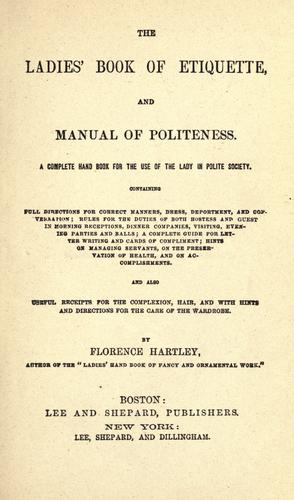I’ve been inspired lately to read (and in some cases skim at the very least) 19th century etiquette manuals, especially those books and sections that pertain to 19th century ballroom etiquette. What got me started was perusing various posts at the blog Recreating the 19th Century Ballroom. Barbara posts tantalizing snippets from these sorts of manuals and I wanted to see the context and read more, so I went back to the original sources.
Looking for one thing leads to another, as you probably know, and so it was with etiquette manuals. Once you find one you are led to others and it’s just one big rabbit hole. In my perusal of these manuals, I’ve come across amusing and interesting sections that I’d like to share. In addition, I’ve also started thinking about 19th century ballroom etiquette and how much or little a modern historic ballroom atmosphere can replicate. It’s really quite fascinating!
I’m planning a series of posts relating to this general topic, exploring some of my thoughts as well as sharing quotes from the manuals. I don’t want to commit to any sort of regular posting, but I’m thinking I’ll just intersperse these posts amongst my usual parade of dressmaking and event pictures with the abbreviation 19CBRE (19th Century Ball Room Etiquette) to note what these posts are about. (It’s not a typo, in these manuals, the word we now spell ballroom was separated into two words “ball room.”)
To start, here is a short quote from The Ladies’ Book of Etiquette, and Manual of Politeness (1873), page 14, source here:
Never use the phrases, “What-d-ye call it,” “Thin-gummy,” “What’s his name,” or any such substitutes for a proper name or place. If you cannot recall the names you wish to use, it is better not to tell the story or incident connected with them. No lady of high breeding will ever use the substitutes in conversation.
I am so guilty of using phrases like this in life (and at historic events…). I forget what I’m talking about within a few seconds of finishing a sentence sometimes! So when I want to continue the conversation these phrases pop right up. According to these 19th century standards, I’m of low breeding and obviously not polite… but in our modern world these phrases, while being casual, don’t mark you as being ill-bred, at least to me. I’ve spent time thinking about the fact that this very casual way of speaking is probably not appropriate for a 19th century lady, but that goes back to my currently unexplored thoughts about how far we choose to go when recreating the past at a public event such as a ball (a topic I’ll be sure to post about, someday!).
But thin-gummy is just so amusing! I really feel like I need to work that into modern conversation just because I can. In fact, I worked it into the title of this post and I hope you can imagine the grin on my face because of it!
Do you use these sorts of phrases in your modern life or at historic events? Had it ever occurred to you that in the 19th century these sorts of phrases were to be avoided?



This is very exciting! I love to peruse period books (and – speaking of rabbit hole – there are soooo many!!!) 🙂
It’s amazing to learn how things have changed or remained. Will you cover books about etiquette of the early 19th century, too?
Possibly! There’s so much amusing and thought provoking mid-century content that I’ve already found, so that’s where I’m planning to start, but I do hope to move on to earlier manuals eventually… :)!
Etiquette books are so funny and fascinating to read. And it really shows just how impolite, careless, and unregulated society could be. After all, if there weren’t people perpetrating these behavioral crimes, they wouldn’t have needed a rule book to try and regulate behavior in polite society. Just think about accounts of people’s behavior at notoriously loose places like Vauxhall and Ranelagh Gardens.
It’s true that we have to consider the context in which these manuals were published. Certainly not everyone in society followed the rules that made one a “lady!”
spwaking of proper language, I love the recent remake of the movie “True Grit” because not a single character uses contractions thru the entire film. Folks in the 19th century did use contractions, but the movie writers made a great (in my opinion) narrative choice not to.
When portraying proper 19th century behavior I often skip the contractions as a way to show the fact that we’re talking formally. It takes some getting used to, but I think it is worth it.
Thanks for adding to the dialogue! I like your consideration of not using contractions. I don’t think I’ve ever consciously tried to do that, but perhaps I will at some event in the future.
How neat! I eagerly look forward to this series (19th century etiquette is so fascinating!) and I had no idea they were using phrases like “What-d-ye call it” in the 1870s. Definitely guilty of that in the 21st century myself!
I hadn’t thought about it that way, that the phrase has been around for so long! After writing this post I’ve been very aware how often I use phrases like this each day… It’s a lot! 🙂